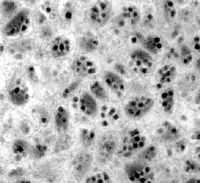
Photo from wikipedia
BACKGROUND Entomopathogenic fungi have developed multiple strategies to overcome the immune defenses of their target insects, whereas insect pests have devised various defense mechanisms to combat fungal infection. However, differences… Click to show full abstract
BACKGROUND Entomopathogenic fungi have developed multiple strategies to overcome the immune defenses of their target insects, whereas insect pests have devised various defense mechanisms to combat fungal infection. However, differences in the molecular mechanisms of the innate immune defense strategies of insects upon infection with different fungal strains from the same species have not been reported. RESULTS Two Beauveria bassiana strains were obtained that significantly varied in their pathogenicity but were comparable in terms of growth, conidial yield, and cuticle penetration. To investigate the molecular mechanisms underlying the immune response of Plutella xylostella infected with these two strains, RNA-Seq was performed 48 h after infection. A total of 1,027 differentially expressed genes (DEGs) were identified, and more than 200 DEGs were enriched in KEGG pathways involved in disease response, revealing differences in the immune response of P. xylostella to different B. bassiana infections at 48 h. Twenty-eight of the DEGs were related to innate immune functions, such as pathogen recognition, immune system activation and antimicrobial reactions. RNAi-mediated gene silencing assays showed that PxApoLIII and PxCSP played critical roles in the P. xylostella immune response. PxApoLIII was expressed at higher levels during infection with the high-virulence strain, whereas PxCSP showed the opposite expression pattern during infection with the low-virulence strain, indicating that PxApoLIII and PxCSP might participate in P. xylostella innate immune defense against high- and low-virulence B. bassiana strains. CONCLUSION The present findings demonstrate that strains of a single species of pathogenic fungi that differ in virulence can induce the expression of different genes in P. xylostella. These results advance our knowledge of the molecular mechanisms underlying fungi-pest interactions. This article is protected by copyright. All rights reserved.
Journal Title: Pest management science
Year Published: 2020
Link to full text (if available)
Share on Social Media: Sign Up to like & get
recommendations!